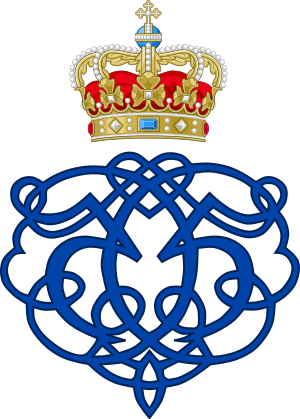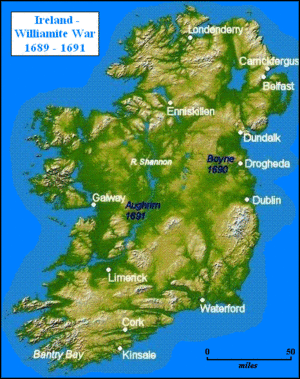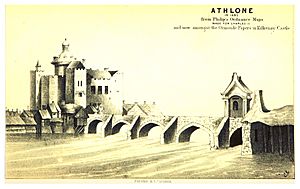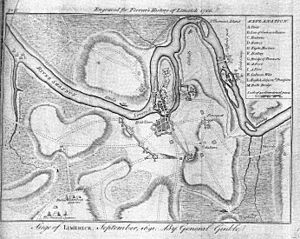Danish Auxiliary Corps in the Williamite War in Ireland facts for kids
Quick facts for kids Danish Auxiliary Corps in Ireland |
|
|---|---|

Royal Monogram of King Christian V of Denmark
|
|
| Active | 1689–1692 |
| Country | |
| Allegiance | |
| Type | Foot and Horse |
| Size | 6,000 foot and 1,000 horse |
| Part of | General-in-chief Frederick Schomberg's Army |
| Engagements | Battle of the Boyne Battle of Aughrim Siege of Limerick (1690) Siege of Cork Siege of Kinsale Siege of Athlone Siege of Galway |
| Commanders | |
| Notable commanders |
Ferdinand Willem, Duke of Württemberg-Neuenstadt |
The Danish Auxiliary Corps was a group of about 7,000 Danish soldiers. They were sent to help William of Orange in his war in Ireland. In 1689, Christian V of Denmark, the king of Denmark–Norway, made a deal with King William III of England. This happened because Denmark was not happy with its old ally, King Louis XIV of France.
The Danish soldiers traveled to Ireland. There, they fought against the Jacobites, who supported King James II. The corps took part in important battles like the Boyne and Aughrim. They also helped in sieges of cities such as Limerick, Cork, Kinsale, Athlone, and Galway. In early 1692, the corps moved to Flanders to continue serving the English.
Contents
Why Denmark Joined the War
Denmark had lost a lot of land to Sweden in earlier wars. These losses happened through treaties like Brømsebro and Roskilde. Denmark tried to get land back in the Scanian War (1675–1679) but failed.
After the war, Denmark tried to take back land from the Duke of Holstein-Gottorp. But other European powers, like the Holy Roman Empire and England, stopped them. Denmark was forced to return the land again in 1689.
Denmark needed to rebuild its army but had no money. They were also upset that France had not supported them. So, Denmark decided to change its alliance. They moved away from Louis XIV of France. Instead, they joined forces with William III of England.
The Treaty of 1689
Denmark-Norway and England signed a military agreement on August 15, 1689. The treaty said that Denmark-Norway would send 1,000 horse soldiers and 6,000 foot soldiers. They would also provide all their equipment. These troops could be sent to England, Scotland, or Ireland.
The Danish soldiers had to promise loyalty to the King of England. If Denmark got into its own war, the troops would return within three months. Also, England would become Denmark's enemy. The English King decided how to use the troops. But they would mostly stay together as one group.
The Danish generals would work with the English general-in-chief. Danish officers would handle military justice for their own troops. The English general would fill any empty officer spots. While in Britain, the Danish troops would get the same pay as the English army. If they went to Europe, they would get Dutch army pay.
Journey to England (1689–1690)
In 1689, the Danish Auxiliary Corps was sent abroad. It had 996 horse soldiers and 6,109 foot soldiers. Their commander was Ferdinand Willem, Duke of Württemberg-Neuenstadt. The corps gathered in Ribe in October. The foot soldiers got on ships at Jordsand, and the horse soldiers at Højer.
A fleet of 80 ships, with six warships, set sail in November. They were crossing the North Sea. But autumn storms scattered the ships. Many ships found shelter in the German Bight. However, one ship with four companies was captured by a French privateer. These soldiers were forced to join the French army. Their officers refused and were kept in prison for a long time.
Most other ships landed on the east coast of England and Scotland. They arrived in November at places like Kingston upon Hull. The soldiers were sick from the sea journey. Those who landed could not march because they had no money for lodging. So, the Danish corps spent the winter of 1689–1690 in towns like York and Newcastle upon Tyne.
In December, they were told to go to Chester. But the corps could not leave York without being paid. The officers had used their own money for two months. They were unhappy that the English had not kept their promises. By January, the Danish foot soldiers marched towards Chester. The King had paid for their winter lodging. But more money was needed for their journey to Ireland.
Fighting in Ireland
1690 Campaigns
In February 1690, the Danish corps marched to Liverpool. In March, they sailed to Belfast. Major fighting did not start until June. That is when King William arrived with the rest of his army.
At the Battle of the Boyne, the Jacobite army was on the south side of the River Boyne. They wanted to stop King William's army from crossing. On July 1, King William ordered his right side to cross the river upstream. This was to surround the Jacobite army. King James sent many soldiers to his left side.
The Jacobite left side met William's right side at Roughgrange. But a deep valley stopped a big battle there. This left fewer Jacobite soldiers to face William's main army. William's army crossed the river at Oldbridge under heavy fire. When William's cavalry crossed downstream, the Jacobite army began to retreat.
The Danish foot soldiers helped cross the river at Oldbridge. The Danish horse soldiers crossed downstream with the cavalry. In total, the Danish corps had 28 killed and 43 wounded. Most of these were among the horse soldiers.
The Danish corps played a key role during the Siege of Limerick. On August 7, 100 Danish horse soldiers led the attack on the city. They were followed by other troops. The Danish foot soldiers formed the front line. They attacked Ireton's fort. Fifty Danish pioneers led the way, followed by grenadiers. The Jacobites were forced to leave the fort, and two Danish battalions took it.
On August 16, the Irish attacked the Williamite camp. But the Danish Guards quickly pushed them back. On August 17, the Williamite trenches were opened. Danish battalions helped in the attack. Captain Arenswald and his grenadiers took a fort on the left side. The next morning, the Jacobites attacked. But a Danish and a Dutch battalion drove them back.
On August 27, Williamite cannons made a big hole in the city walls. The attack started at 2:30 PM. Nine grenadier companies led the charge. The Funen Battalion and a Brandenburg battalion supported them. At first, the Jacobites were pushed back. But then they drove the attackers back. The Funen Battalion was cut off but saved by another battalion. The fighting lasted until dark. King William finally stopped the attack. The Danish losses were 136 killed, including Colonel Kalneyn, and 305 wounded.
After the failed siege of Limerick, King William left Ireland in September. The Williamite army went into winter quarters. The Danish corps stayed in counties like Tipperary and Cork. But fighting was not over. Major-General de la Forest-Suzannet went to Killmallock with soldiers. The town was empty, and the Danes took the supplies.
Major-general von Tettau and Dutch Major-General Scravenmoer took control of some mountain passes. This stopped communication between Cork and Limerick. On September 13, their troops defeated Jacobite forces. These were mostly Rapparees, led by Colonel Sheldon.
Marlborough landed near Cork on September 22. He began to besiege the city. The Duke of Würtemberg marched to Cork with Danish soldiers. They took a position outside the city walls. Under Major-general von Tettau, the troops entered the city. They pushed the Jacobite defenders back into the city.
The attack on the city began on September 27. A force of grenadiers and foot soldiers, including 300 Danes, crossed the River Lee. They reached a moat in front of the walls. The main attack came from the south. Soon, the defenders surrendered.
After Cork, Würtemberg's and Marlborough's forces went to Kinsale. They arrived on October 2. Major-general von Tettau attacked James's Fort. The troops crossed the water at night. In the morning, the defenders left their outer defenses. Tettau began the attack. After a short fight, the Jacobites were pushed back into the fort. An explosion in the gunpowder storage killed many defenders. The commander then surrendered. The Danish troops had 24 casualties. After a siege until October 17, the city finally gave up.
1691 Campaigns
The Williamite army left their winter camps in May. The Danish corps was part of the Duke of Würtemberg's group. This group had 14 battalions of foot soldiers, six of them Danish. Two Danish battalions stayed in Waterford and Clonmel. Würtemberg's group joined the main army at Ballymore. The campaign started on June 6 when Ballymore was taken.
The army reached Athlone on June 18. The famous siege began the next day. The "English Town" part of Athlone was taken on June 20. The Jacobite defenders then went to the "Irish Town" across the River Shannon. They destroyed the bridge. Williamite cannons bombed the Irish Town. They damaged the castle and made a big hole in the wall.
The Irish repaired the bridge on June 29. But the Williamites immediately destroyed it again. The next day, 600 grenadiers crossed the river upstream. They took the western walls and held them. The Jacobites realized their danger and left the town. During the Siege of Athlone, about one hundred Danish soldiers were killed or wounded.
After taking Athlone, the Williamite army moved towards the main Jacobite army. This was on July 11, at Aughrim. The next day, the decisive battle of Aughrim happened. The Jacobite army held a ridge for two miles. Walls and a bog were in front of them.
William's right side attacked the Jacobite positions but was pushed back. William's foot soldiers attacked across the bog. They reached the ridge but were driven back again. The Danish horse soldiers saved them from being chased. Würtemberg's left side, with the Danish foot soldiers, moved slowly forward.
The Danish Guard fought very well. When four Jacobite battalions attacked them, they held their ground. They even pushed the attackers back. Würtemberg's horse soldiers charged, and the Danish foot soldiers advanced. The Jacobite right side was forced to move. Their commander, St Ruth, was killed. The Jacobite army became disorganized. William's horse soldiers broke through the Jacobite lines. Soon, the Jacobites retreated in confusion. Colonel Munchgaard of the Danish corps was killed in the battle.
The campaign continued. Galway surrendered on July 25 after a short siege. The outer defenses were taken on July 20. When enemy relief forces were defeated, the town gave up. The main Williamite army then marched towards Limerick. The second siege would be more successful.
The attackers began digging trenches on August 27. On September 3, the siege cannons started firing. The cannons caused much damage to the city's defenses. But high water made an attack difficult. So, a large force crossed the Shannon on September 22. They drove away the Jacobite cavalry outside the city. They then advanced from the west. The soldiers in a fort on the west side were pushed towards the Thomond Bridge. But the defenders closed the gate. This left the fleeing troops to die under the walls. During this fight, 23 Danish soldiers were killed or wounded. A ceasefire began on September 23, and the city surrendered on October 3.
After Limerick, the Danish corps and most other foreign troops were ordered to Flanders. The Corps left Limerick on October 14. They stayed in various towns until they could be transported. The Danish horse soldiers stayed in Clonmel, Cashel, and Carrick. The Danish foot soldiers stayed in Waterford, Youghal, Cork, and Kinsale.
Notable Commanders
- Lieutenant-General Ferdinand Willem, Duke of Württemberg-Neuenstadt was the overall commander.
- Major-General of Horse was Marquess Frédéric Henri de La Forest de Suzannet.
- Major-General of Foot was Ernst von Tettau.
|
See also




